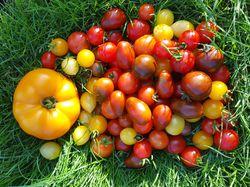 For some years now, when breeding new tomato varieties, we have concentrated on outdoor tomatoes that are largely resistant to blight and Alternaria. In discussions, we have heard time and again that the resistance argument is not important regarding tomatoes, that customers would focus on taste, on compact growth types or on diversity (colours, shapes, stripes). Sometimes even the suspicion was expressed that the building of tomato roofs, tomato houses and the like was just part of growing tomatoes; and that this supposedly favourite activity should not be taken away from the builders among the gardeners...In spring 2022, we introduced the new outdoor tomatoes from our own breeding programme, the so-called Open Sky® tomatoes, in the Lubera® Garden Shop and took this opportunity to test the acceptance of the category outdoor tomatoes and the Open Sky® tomatoes.
For some years now, when breeding new tomato varieties, we have concentrated on outdoor tomatoes that are largely resistant to blight and Alternaria. In discussions, we have heard time and again that the resistance argument is not important regarding tomatoes, that customers would focus on taste, on compact growth types or on diversity (colours, shapes, stripes). Sometimes even the suspicion was expressed that the building of tomato roofs, tomato houses and the like was just part of growing tomatoes; and that this supposedly favourite activity should not be taken away from the builders among the gardeners...In spring 2022, we introduced the new outdoor tomatoes from our own breeding programme, the so-called Open Sky® tomatoes, in the Lubera® Garden Shop and took this opportunity to test the acceptance of the category outdoor tomatoes and the Open Sky® tomatoes.
What are outdoor tomatoes and Open Sky® tomatoes?
Perhaps we should start by defining the term 'outdoor tomatoes': for us, outdoor tomatoes are tomato varieties that can be grown outdoors without any weather protection and that still have 70-80% healthy leaves until the end of September. Currently, almost all of the varieties in question are vine tomatoes, whereby very many grow strongly and can easily be grown with two shoots. We have offered a total of 13 outdoor tomato varieties in the Lubera® Garden Shop in spring 2022, four of which are Open Sky® tomatoes from our own breeding programme. Open Sky® is the self-explanatory and speaking brand name for the outdoor tomatoes bred by Lubera and offered as young plants by Lubera Edibles. Most of the other varieties that have passed our resistance tests in recent years and are offered as outdoor tomatoes come from the breeder Culinaris. In the Lubera trials, we have seen that the known resistances Ph1 to 3 are not sufficient for an outdoor tomato, so that additional resistances and tolerances have to be crossed in and bred in, which is now the case with all the varieties offered.
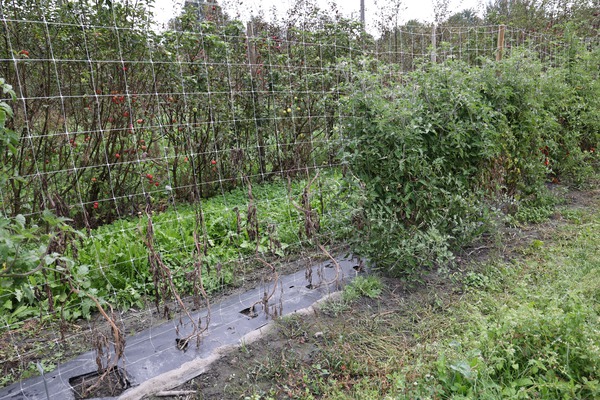
Picture: The tomato plot in Buchs in the second half of September 2021; the difference between a conventional variety (left; dead) and an Open Sky® tomato variety (right; still completely green foliage), in this case Open Sky® Happy Black®.
Which tomatoes were offered, in which form and where?
The trial sales evaluated here took place on Lubera.com, in the DACH region (Germany, Austria and Switzerland). A total of almost 20,000 tomato plants were sold online, all in large 1.3 litre pots. The prices were in the premium segment: 8.90 in Switzerland, 5.45 in Germany and Austria. There were no promotions or special offers during the season, except for an end-of-season sale for all tomato varieties at the end of May. Tomatoes were sold from the beginning of April until the end of May, but only delivered from the beginning of May. The new Open Sky® tomatoes went on sale two weeks late (mid-April), but were featured in one of the weekly newsletters.
A total of 46 tomato varieties were offered, divided into the following groups (categories in the shop):
- 12 outdoor tomatoes
- 8 patio tomatoes (here we combined hanging tomatoes, balcony tomatoes and bush tomatoes)
- 4 wild tomatoes, e.g. the currant tomato or the Peruvian wild tomato
- 17 heirloom tomatoes (this includes the coloured, striped varieties such as 'Green Zebra' or 'Indigo' as well as old varieties such as 'Berner Rosen' or 'Orange Wellington'; almost all these varieties are also listed in special categories for their colours (black, striped, etc.).
- 5 gourmet tomatoes
In addition, as I said, there were some other categories that featured certain other characteristics, e.g. the size of the tomato (beefsteak tomatoes, salad tomatoes, cherry tomatoes) or also the colour of the tomatoes, especially the black and the striped tomatoes. But in these additional categories, the same varieties from the above main categories appeared again.
The sales results of the tomato sales
The sales results are surprisingly clear. Of the almost 20,000 tomato plants sold, the sales are distributed among the main categories as follows:

Picture: Overview of total tomato sales by main categories.
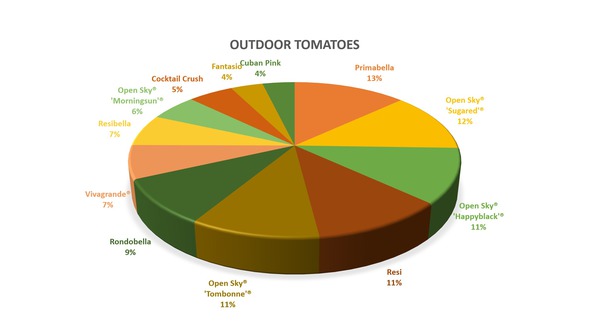
Picture: Overview of outdoor tomatoes sold by variety.
The high achievers: outdoor tomatoes
Outdoor tomatoes are the surprising and clear high achievers. With 12 varieties, they are of course relatively well represented, but all five best-selling varieties are outdoor tomatoes, including three Open Sky® tomatoes from the Lubera breeding programme. It is quite clear that these varieties, which are largely unknown, meet an urgent need of the customers. Yes, they definitely want to grow tomatoes, but they also want to harvest tomatoes in any case, and in our climate this is only possible with outdoor tomatoes or an elaborate tomato houses (which in many cases is not even enough). Actually, the customers want to make the tomato native for good, so that they can be grown without a greenhouse and other constructions. All other possible advantages (compact growth, for balconies and terraces, gourmet taste, etc.) take a back seat to this main argument. This awareness is all the more important because at the point of sale the resistance and simplicity argument is very rarely, if ever, encountered. The topic is bashfully left out because 97% of the varieties do not meet these requirements (that without protection there are 70-80% healthy leaves by the end of September). Balcony tomatoes, vine tomatoes, bush tomatoes, cherry tomatoes and cocktail tomatoes are mostly sold at physical points of sale – these terms give information about the size and the type of fruits and plants, but they refuse to give information about the ease of cultivation. As soon as you give this information and also provide a strong assortment (outdoor tomatoes, Open Sky® tomatoes), the customers grab with both hands.
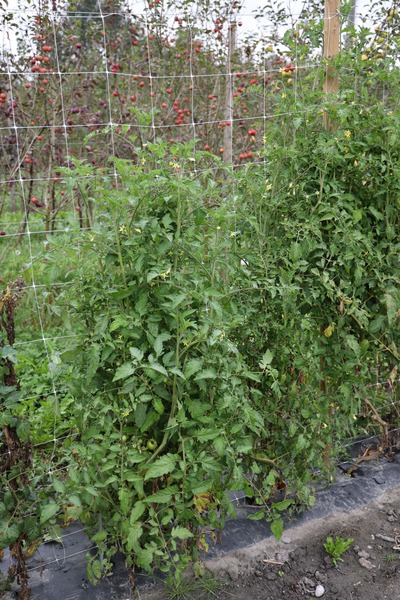
Picture: This is how the amateur gardener wants his tomato plants, green and healthy foliage from bottom to top until autumn. Shown here: Open Sky® Tombonne® outdoor tomato.
Tomato colours and markings don't draw sales
A tomato is and remains...red. This can be seen quite clearly with the yellow tomatoes, which we sell as a variety only about half as much as a comparable red variety: Open Sky® 'Morning Sun'® sold only about 40% of the plants of Open Sky® 'Sugared'®. But also the large, diversified assortment with 17 heirloom tomatoes (including striped, black, blue tomatoes and some old varieties) did not draw sales at all. Although this was the strongest tomato group in terms of the number of varieties on offer (this is the only way to show diversity), it only accounted for 20% of sales with just under half of all tomato varieties. The black-blue tomatoes with sales figures below 100 plants (varieties like 'Blueberry', 'Indigo Blueberry') or special forms like 'Dattelwein' or 'Chocolate Pear' were particularly negatively conspicuous. This simply does not seem to be in demand.
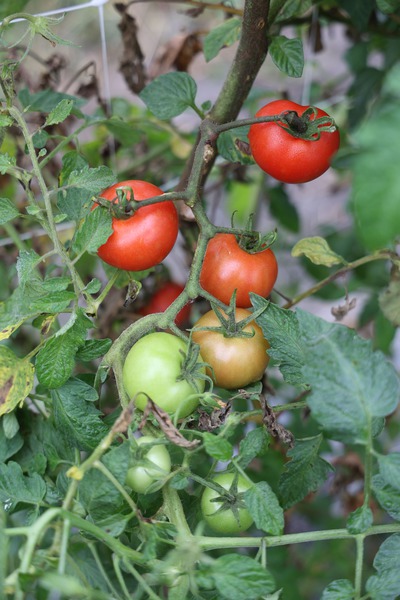
Picture: the classic tomato still has to be red at the end customer - open field truss tomato Open Sky® Tombonne® - our salad tomato
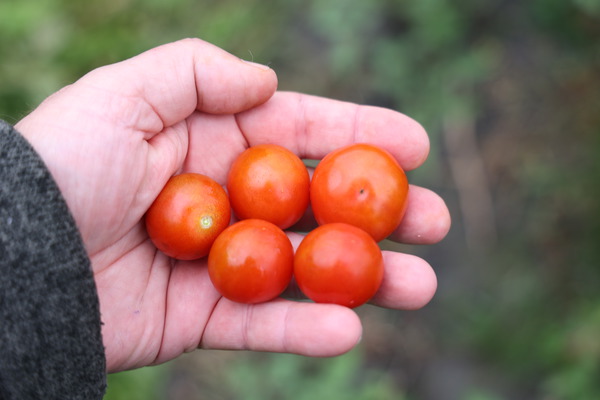
Picture: or our sugary sweet outdoor cherry tomato Open Sky® Sugared®.
Black and red tomatoes, on the other hand, can be successful: our first black outdoor tomato 'Happy Black'® was immediately among the five best-selling tomato varieties – but the prerequisite is that it can also be cultivated easily, without problems and without plant protection.
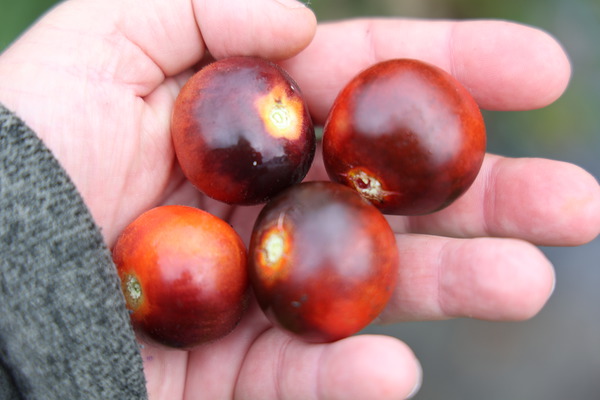
Picture: even if the classic tomato has to be red, the colored varieties should not be underestimated - our dark outdoor cherry tomato Open Sky® Happyblack® still made it into the top 5 best-selling varieties in 2022
Wild is always good, only it should be more resistant
Wild tomatoes did surprisingly well: they made up 15 % of the sales with only four varieties. This is probably due to the fact that buyers also rightly attribute resistance to them. In fact, this robustness is worlds better than that of a normal tomato, but it is also nowhere near as good as that of outdoor tomatoes. There is still a need for further breeding here; tomato breeders should bring the 'old' wild tomatoes up to the level of the best outdoor tomatoes in order not to disappoint the customers' expectations.
How important is the tomato flavour?
We horticulture professionals, vegetable lovers and growers have learned over the last 10 years to taste tomatoes like...wine. It's unbelievable what comparisons are used to describe the taste of tomatoes; it's just a wonder that wine itself has never had to be used for this. At tomato events, I have seen connoisseurs for whom tasting was not enough; they could no longer eat a tomato without first measuring the sugar content with a refractometer... does the consumer measure tomatoes with a refractometer? Do they really taste tomatoes? No, they simply eat tomatoes, and either the tomatoes are good and ok, or they are not. That this is so simple is shown by the result of the five gourmet tomatoes on offer: they only got 7% of the sales. Now, one could argue that there were only five varieties, but the individual sales of the gourmet tomatoes also speak for themselves; they only reach about 25-30% of the best-selling outdoor tomatoes. Flavour may count, but only if after 500 years the claim is fulfilled to make the tomato really native in our region, so that it can also be cultivated north of the Alps without additional protection.
Conclusion
Customers want to grow resistant and easy outdoor or Open Sky® tomatoes. This desire is stronger than other possible tomato desires (flavour, compact growth, different fruit types or tastes). The rumour that in every vegetable gardener there is also a DIY freak does not correspond in any way to the truth. On the contrary: gardeners would like to finally cultivate tomatoes without having to use to power drill to construct a tomato house! It is up to us as growers to improve and expand this range as quickly as possible. And also the marketing to the end consumers will not get around directly addressing and selling this segment: we have the Open Sky® tomatoes that you can easily grow outdoors!
